Business Law Assignment: Contract, Negligence, ACL, Joint Venture
VerifiedAdded on 2021/05/31
|11
|1518
|19
Homework Assignment
AI Summary
This business law assignment analyzes five distinct legal issues. The first issue concerns a breach of contract, focusing on offer and acceptance, and determines whether a party can bring legal action based on communication methods. The second issue examines the nature of a business relationship, differentiating between a joint venture and a partnership. The third issue evaluates the enforceability of an exclusion clause under contract law and the Australian Consumer Law (ACL). The fourth issue addresses negligence, specifically the duty of care and potential liability of a supermarket for customer injury, and the type of insurance the supermarket might have. The fifth issue explores misleading and deceptive conduct under the ACL, examining the liability of a business for its agents' false statements and the potential for legal action. Each issue includes relevant legal rules, their application to the facts, and a conclusion. The assignment references relevant case law and legislation to support the analysis.
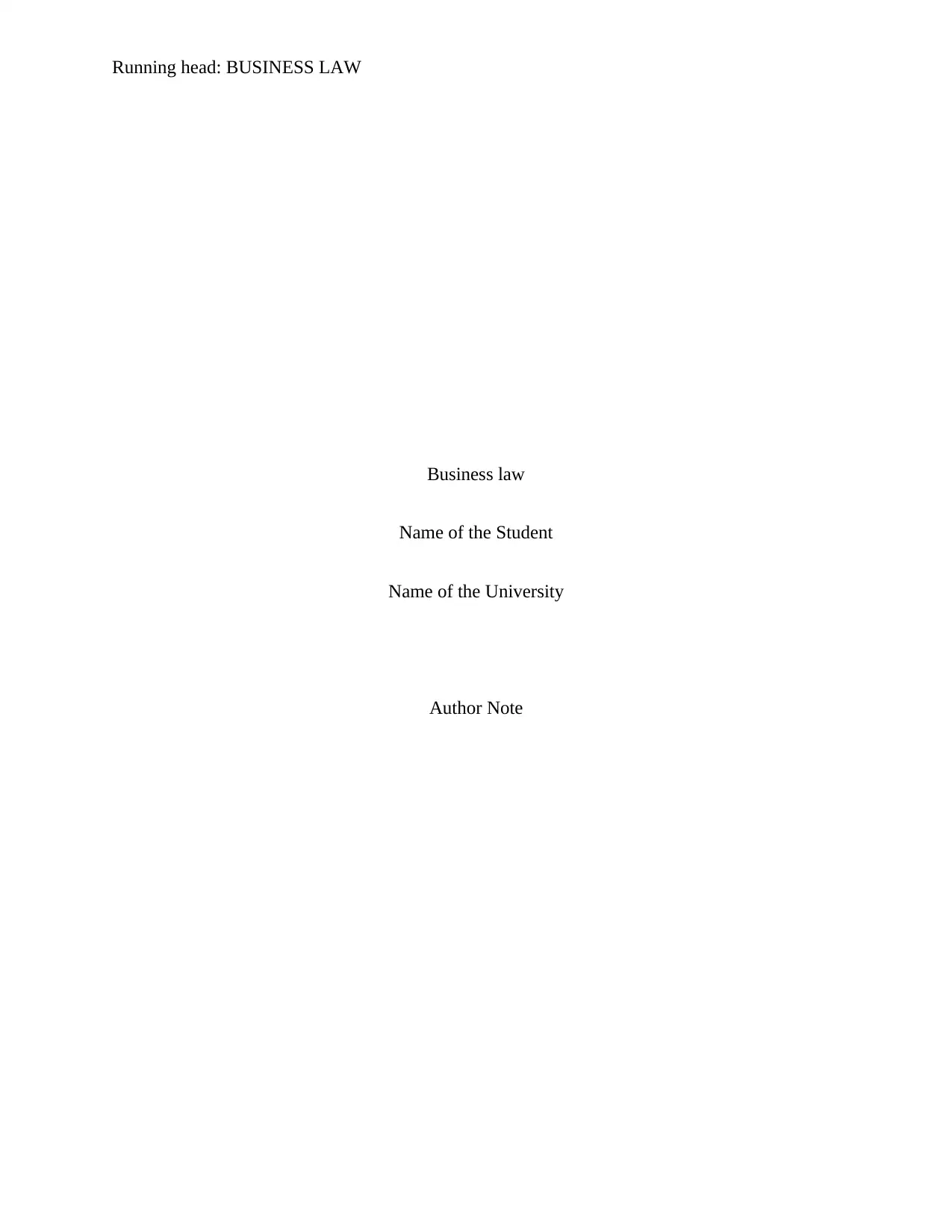
Running head: BUSINESS LAW
Business law
Name of the Student
Name of the University
Author Note
Business law
Name of the Student
Name of the University
Author Note
Paraphrase This Document
Need a fresh take? Get an instant paraphrase of this document with our AI Paraphraser
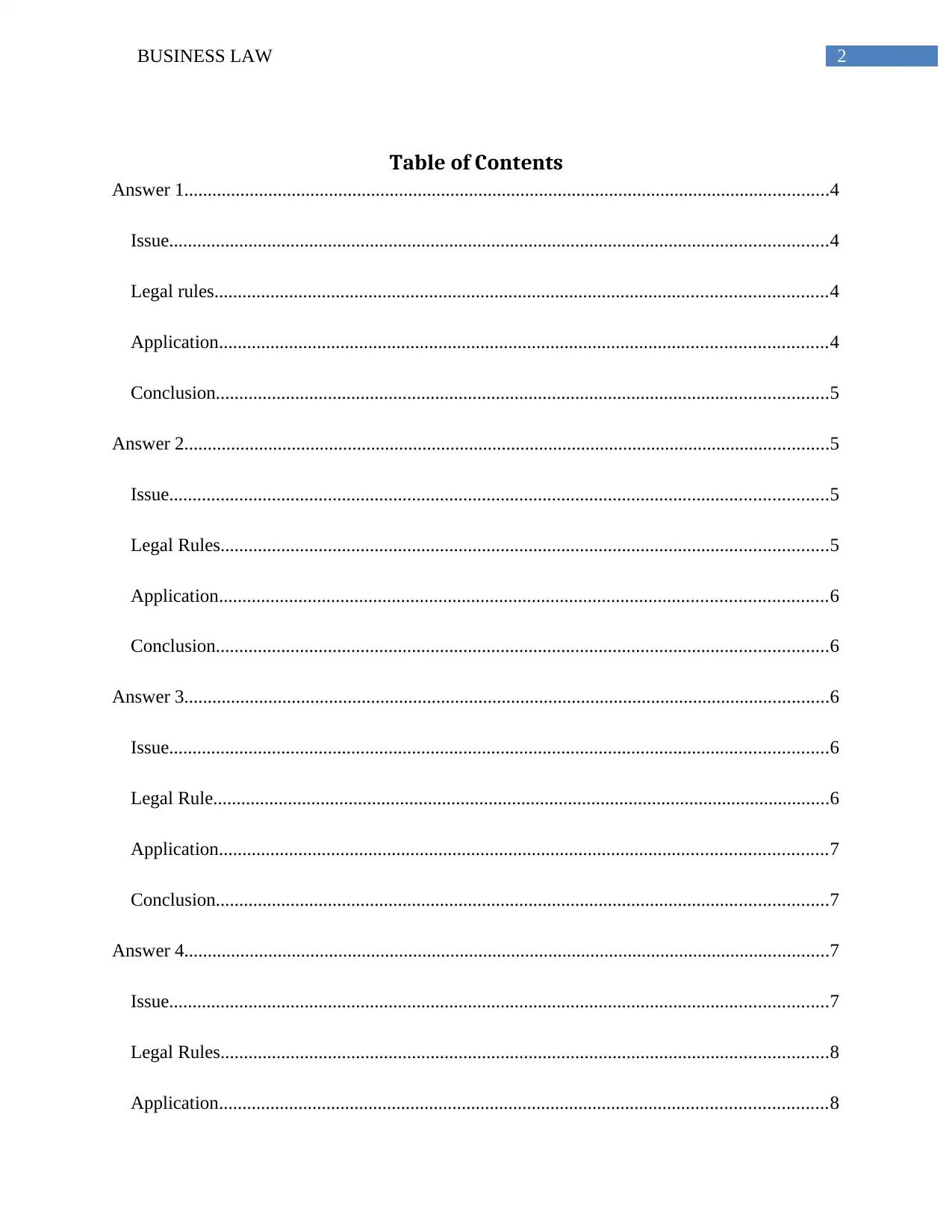
2BUSINESS LAW
Table of Contents
Answer 1..........................................................................................................................................4
Issue.............................................................................................................................................4
Legal rules...................................................................................................................................4
Application..................................................................................................................................4
Conclusion...................................................................................................................................5
Answer 2..........................................................................................................................................5
Issue.............................................................................................................................................5
Legal Rules..................................................................................................................................5
Application..................................................................................................................................6
Conclusion...................................................................................................................................6
Answer 3..........................................................................................................................................6
Issue.............................................................................................................................................6
Legal Rule....................................................................................................................................6
Application..................................................................................................................................7
Conclusion...................................................................................................................................7
Answer 4..........................................................................................................................................7
Issue.............................................................................................................................................7
Legal Rules..................................................................................................................................8
Application..................................................................................................................................8
Table of Contents
Answer 1..........................................................................................................................................4
Issue.............................................................................................................................................4
Legal rules...................................................................................................................................4
Application..................................................................................................................................4
Conclusion...................................................................................................................................5
Answer 2..........................................................................................................................................5
Issue.............................................................................................................................................5
Legal Rules..................................................................................................................................5
Application..................................................................................................................................6
Conclusion...................................................................................................................................6
Answer 3..........................................................................................................................................6
Issue.............................................................................................................................................6
Legal Rule....................................................................................................................................6
Application..................................................................................................................................7
Conclusion...................................................................................................................................7
Answer 4..........................................................................................................................................7
Issue.............................................................................................................................................7
Legal Rules..................................................................................................................................8
Application..................................................................................................................................8
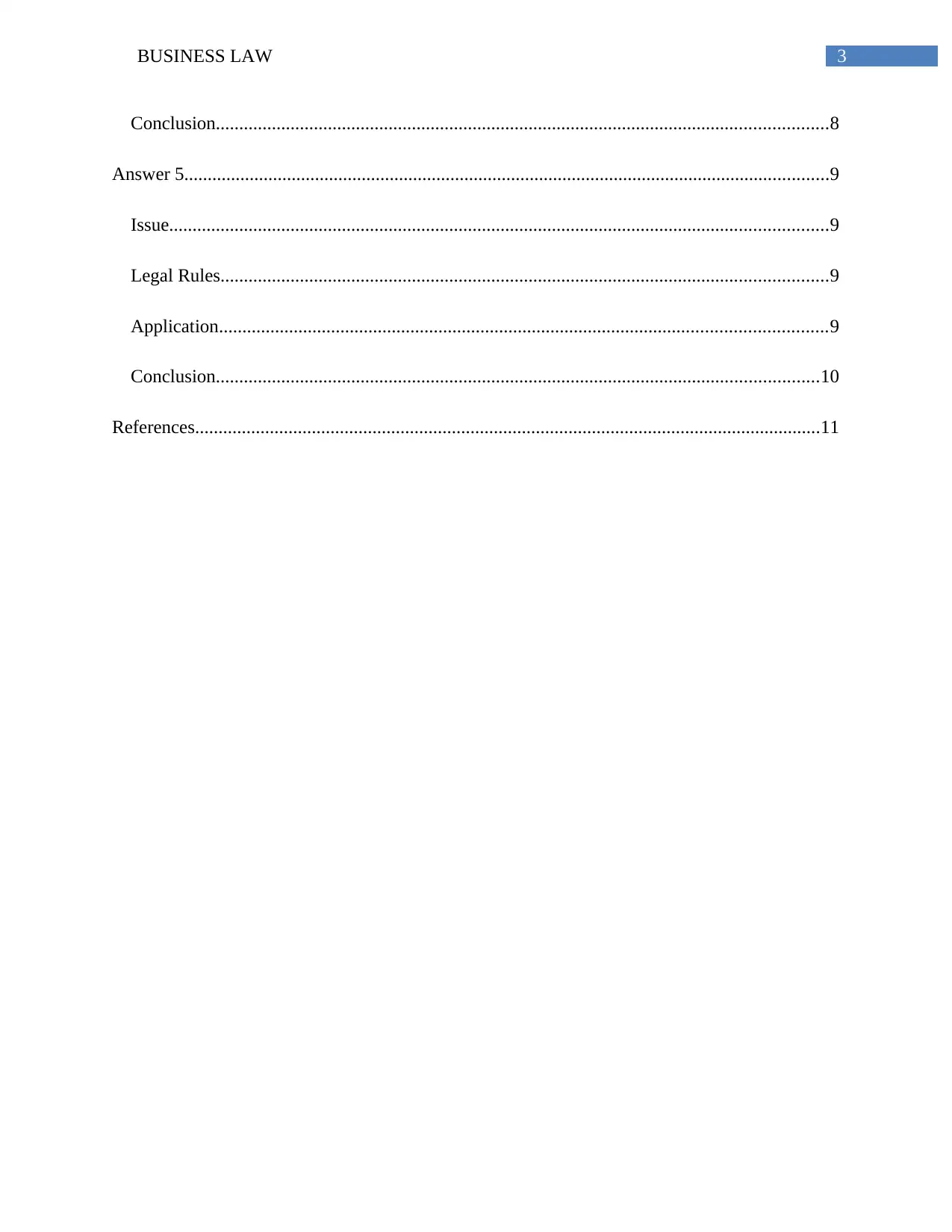
3BUSINESS LAW
Conclusion...................................................................................................................................8
Answer 5..........................................................................................................................................9
Issue.............................................................................................................................................9
Legal Rules..................................................................................................................................9
Application..................................................................................................................................9
Conclusion.................................................................................................................................10
References......................................................................................................................................11
Conclusion...................................................................................................................................8
Answer 5..........................................................................................................................................9
Issue.............................................................................................................................................9
Legal Rules..................................................................................................................................9
Application..................................................................................................................................9
Conclusion.................................................................................................................................10
References......................................................................................................................................11
⊘ This is a preview!⊘
Do you want full access?
Subscribe today to unlock all pages.

Trusted by 1+ million students worldwide
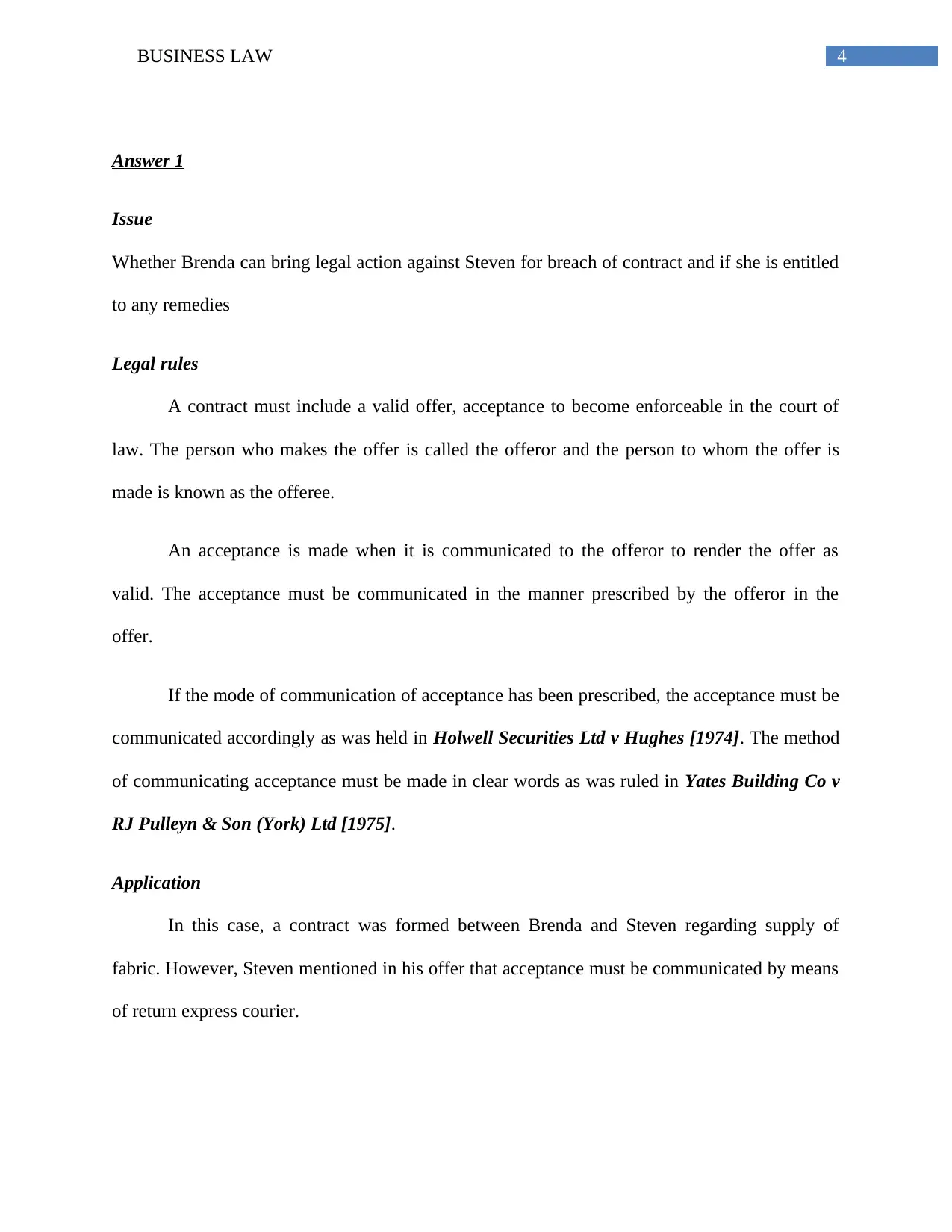
4BUSINESS LAW
Answer 1
Issue
Whether Brenda can bring legal action against Steven for breach of contract and if she is entitled
to any remedies
Legal rules
A contract must include a valid offer, acceptance to become enforceable in the court of
law. The person who makes the offer is called the offeror and the person to whom the offer is
made is known as the offeree.
An acceptance is made when it is communicated to the offeror to render the offer as
valid. The acceptance must be communicated in the manner prescribed by the offeror in the
offer.
If the mode of communication of acceptance has been prescribed, the acceptance must be
communicated accordingly as was held in Holwell Securities Ltd v Hughes [1974]. The method
of communicating acceptance must be made in clear words as was ruled in Yates Building Co v
RJ Pulleyn & Son (York) Ltd [1975].
Application
In this case, a contract was formed between Brenda and Steven regarding supply of
fabric. However, Steven mentioned in his offer that acceptance must be communicated by means
of return express courier.
Answer 1
Issue
Whether Brenda can bring legal action against Steven for breach of contract and if she is entitled
to any remedies
Legal rules
A contract must include a valid offer, acceptance to become enforceable in the court of
law. The person who makes the offer is called the offeror and the person to whom the offer is
made is known as the offeree.
An acceptance is made when it is communicated to the offeror to render the offer as
valid. The acceptance must be communicated in the manner prescribed by the offeror in the
offer.
If the mode of communication of acceptance has been prescribed, the acceptance must be
communicated accordingly as was held in Holwell Securities Ltd v Hughes [1974]. The method
of communicating acceptance must be made in clear words as was ruled in Yates Building Co v
RJ Pulleyn & Son (York) Ltd [1975].
Application
In this case, a contract was formed between Brenda and Steven regarding supply of
fabric. However, Steven mentioned in his offer that acceptance must be communicated by means
of return express courier.
Paraphrase This Document
Need a fresh take? Get an instant paraphrase of this document with our AI Paraphraser
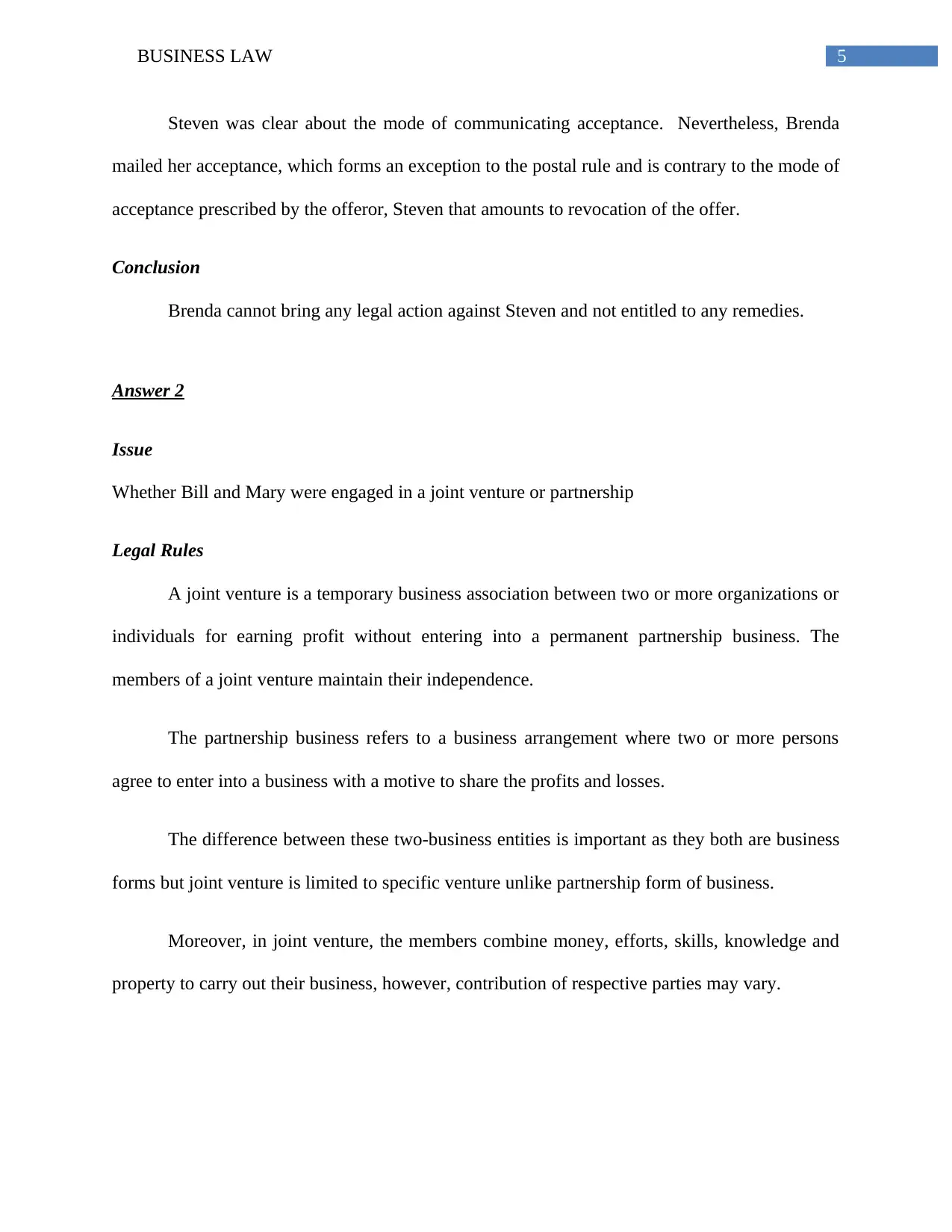
5BUSINESS LAW
Steven was clear about the mode of communicating acceptance. Nevertheless, Brenda
mailed her acceptance, which forms an exception to the postal rule and is contrary to the mode of
acceptance prescribed by the offeror, Steven that amounts to revocation of the offer.
Conclusion
Brenda cannot bring any legal action against Steven and not entitled to any remedies.
Answer 2
Issue
Whether Bill and Mary were engaged in a joint venture or partnership
Legal Rules
A joint venture is a temporary business association between two or more organizations or
individuals for earning profit without entering into a permanent partnership business. The
members of a joint venture maintain their independence.
The partnership business refers to a business arrangement where two or more persons
agree to enter into a business with a motive to share the profits and losses.
The difference between these two-business entities is important as they both are business
forms but joint venture is limited to specific venture unlike partnership form of business.
Moreover, in joint venture, the members combine money, efforts, skills, knowledge and
property to carry out their business, however, contribution of respective parties may vary.
Steven was clear about the mode of communicating acceptance. Nevertheless, Brenda
mailed her acceptance, which forms an exception to the postal rule and is contrary to the mode of
acceptance prescribed by the offeror, Steven that amounts to revocation of the offer.
Conclusion
Brenda cannot bring any legal action against Steven and not entitled to any remedies.
Answer 2
Issue
Whether Bill and Mary were engaged in a joint venture or partnership
Legal Rules
A joint venture is a temporary business association between two or more organizations or
individuals for earning profit without entering into a permanent partnership business. The
members of a joint venture maintain their independence.
The partnership business refers to a business arrangement where two or more persons
agree to enter into a business with a motive to share the profits and losses.
The difference between these two-business entities is important as they both are business
forms but joint venture is limited to specific venture unlike partnership form of business.
Moreover, in joint venture, the members combine money, efforts, skills, knowledge and
property to carry out their business, however, contribution of respective parties may vary.
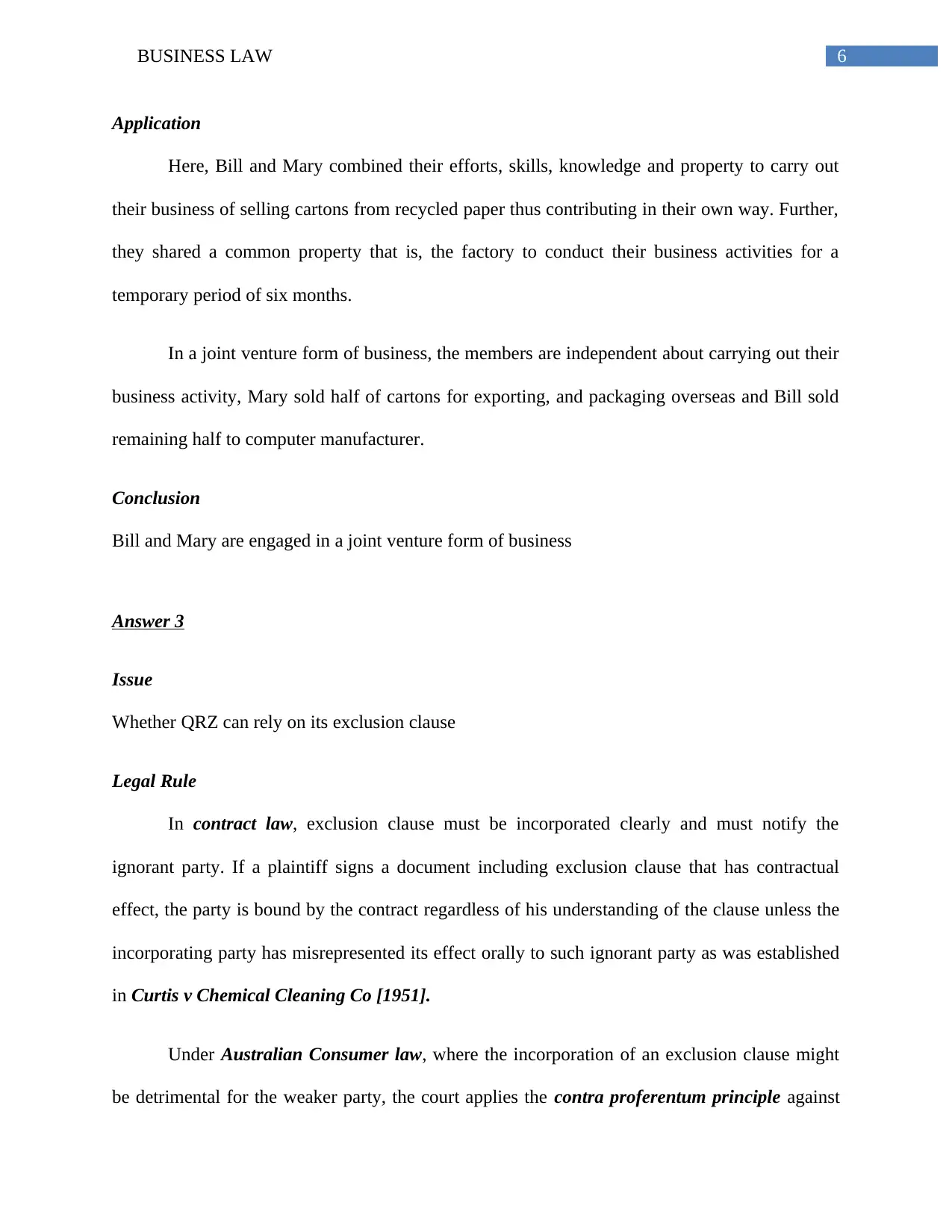
6BUSINESS LAW
Application
Here, Bill and Mary combined their efforts, skills, knowledge and property to carry out
their business of selling cartons from recycled paper thus contributing in their own way. Further,
they shared a common property that is, the factory to conduct their business activities for a
temporary period of six months.
In a joint venture form of business, the members are independent about carrying out their
business activity, Mary sold half of cartons for exporting, and packaging overseas and Bill sold
remaining half to computer manufacturer.
Conclusion
Bill and Mary are engaged in a joint venture form of business
Answer 3
Issue
Whether QRZ can rely on its exclusion clause
Legal Rule
In contract law, exclusion clause must be incorporated clearly and must notify the
ignorant party. If a plaintiff signs a document including exclusion clause that has contractual
effect, the party is bound by the contract regardless of his understanding of the clause unless the
incorporating party has misrepresented its effect orally to such ignorant party as was established
in Curtis v Chemical Cleaning Co [1951].
Under Australian Consumer law, where the incorporation of an exclusion clause might
be detrimental for the weaker party, the court applies the contra proferentum principle against
Application
Here, Bill and Mary combined their efforts, skills, knowledge and property to carry out
their business of selling cartons from recycled paper thus contributing in their own way. Further,
they shared a common property that is, the factory to conduct their business activities for a
temporary period of six months.
In a joint venture form of business, the members are independent about carrying out their
business activity, Mary sold half of cartons for exporting, and packaging overseas and Bill sold
remaining half to computer manufacturer.
Conclusion
Bill and Mary are engaged in a joint venture form of business
Answer 3
Issue
Whether QRZ can rely on its exclusion clause
Legal Rule
In contract law, exclusion clause must be incorporated clearly and must notify the
ignorant party. If a plaintiff signs a document including exclusion clause that has contractual
effect, the party is bound by the contract regardless of his understanding of the clause unless the
incorporating party has misrepresented its effect orally to such ignorant party as was established
in Curtis v Chemical Cleaning Co [1951].
Under Australian Consumer law, where the incorporation of an exclusion clause might
be detrimental for the weaker party, the court applies the contra proferentum principle against
⊘ This is a preview!⊘
Do you want full access?
Subscribe today to unlock all pages.

Trusted by 1+ million students worldwide
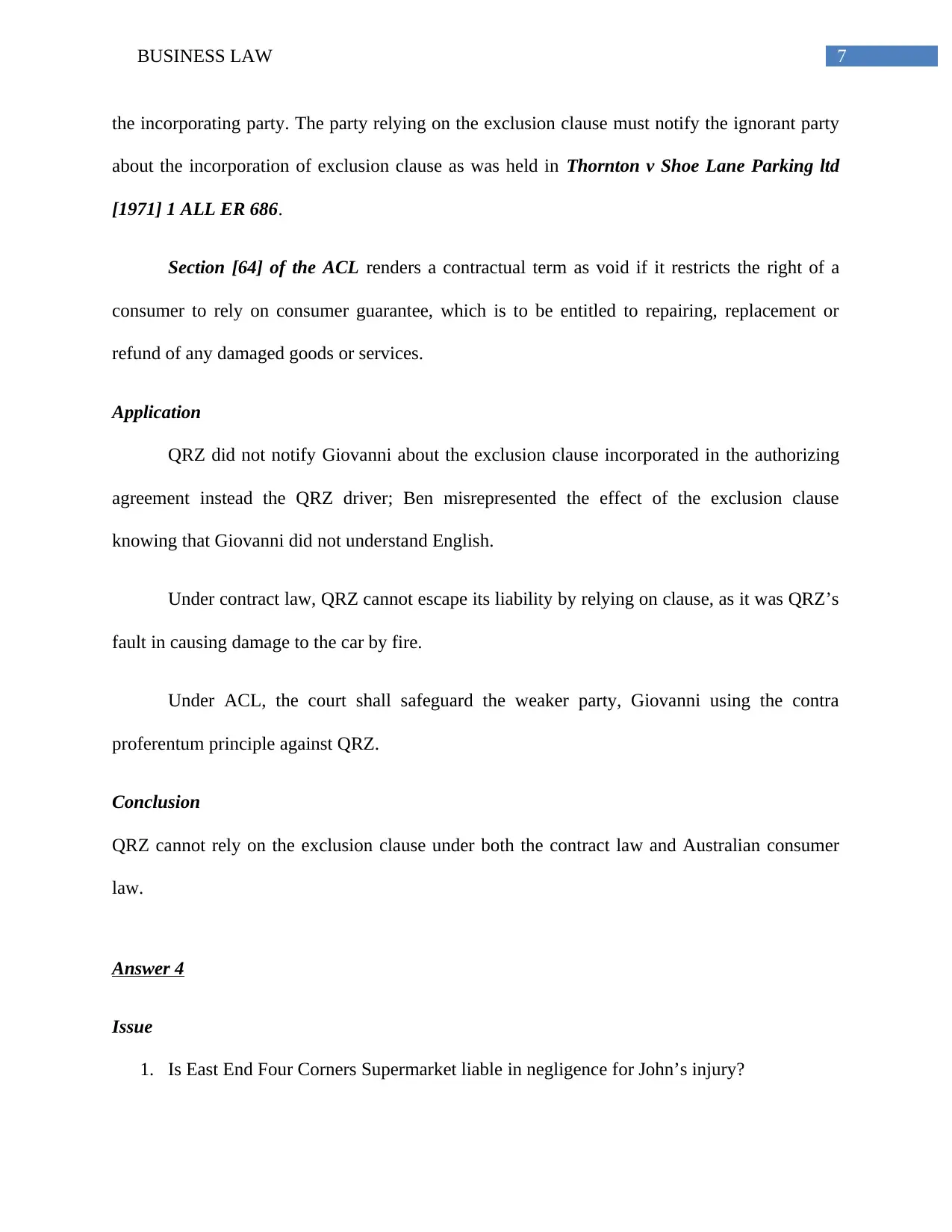
7BUSINESS LAW
the incorporating party. The party relying on the exclusion clause must notify the ignorant party
about the incorporation of exclusion clause as was held in Thornton v Shoe Lane Parking ltd
[1971] 1 ALL ER 686.
Section [64] of the ACL renders a contractual term as void if it restricts the right of a
consumer to rely on consumer guarantee, which is to be entitled to repairing, replacement or
refund of any damaged goods or services.
Application
QRZ did not notify Giovanni about the exclusion clause incorporated in the authorizing
agreement instead the QRZ driver; Ben misrepresented the effect of the exclusion clause
knowing that Giovanni did not understand English.
Under contract law, QRZ cannot escape its liability by relying on clause, as it was QRZ’s
fault in causing damage to the car by fire.
Under ACL, the court shall safeguard the weaker party, Giovanni using the contra
proferentum principle against QRZ.
Conclusion
QRZ cannot rely on the exclusion clause under both the contract law and Australian consumer
law.
Answer 4
Issue
1. Is East End Four Corners Supermarket liable in negligence for John’s injury?
the incorporating party. The party relying on the exclusion clause must notify the ignorant party
about the incorporation of exclusion clause as was held in Thornton v Shoe Lane Parking ltd
[1971] 1 ALL ER 686.
Section [64] of the ACL renders a contractual term as void if it restricts the right of a
consumer to rely on consumer guarantee, which is to be entitled to repairing, replacement or
refund of any damaged goods or services.
Application
QRZ did not notify Giovanni about the exclusion clause incorporated in the authorizing
agreement instead the QRZ driver; Ben misrepresented the effect of the exclusion clause
knowing that Giovanni did not understand English.
Under contract law, QRZ cannot escape its liability by relying on clause, as it was QRZ’s
fault in causing damage to the car by fire.
Under ACL, the court shall safeguard the weaker party, Giovanni using the contra
proferentum principle against QRZ.
Conclusion
QRZ cannot rely on the exclusion clause under both the contract law and Australian consumer
law.
Answer 4
Issue
1. Is East End Four Corners Supermarket liable in negligence for John’s injury?
Paraphrase This Document
Need a fresh take? Get an instant paraphrase of this document with our AI Paraphraser
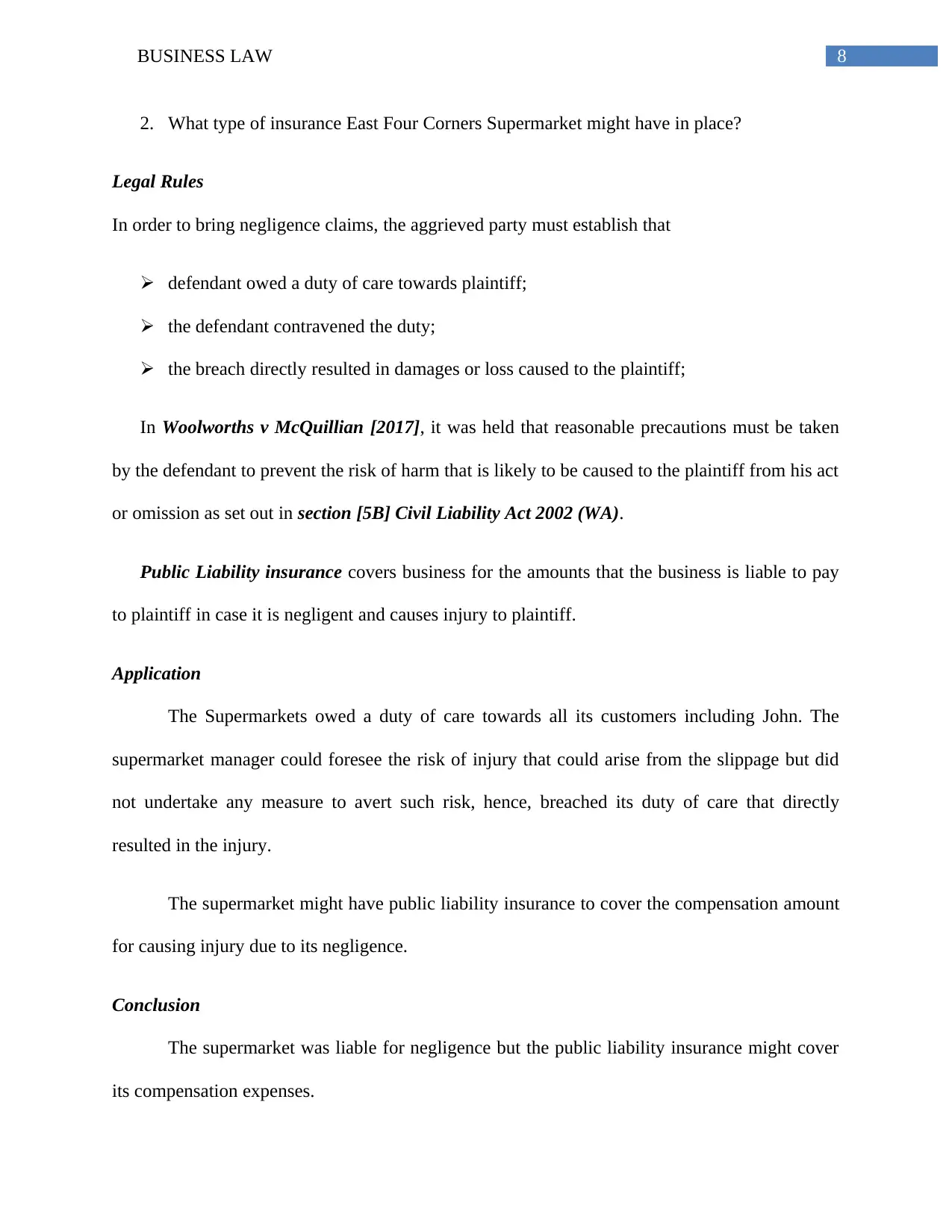
8BUSINESS LAW
2. What type of insurance East Four Corners Supermarket might have in place?
Legal Rules
In order to bring negligence claims, the aggrieved party must establish that
defendant owed a duty of care towards plaintiff;
the defendant contravened the duty;
the breach directly resulted in damages or loss caused to the plaintiff;
In Woolworths v McQuillian [2017], it was held that reasonable precautions must be taken
by the defendant to prevent the risk of harm that is likely to be caused to the plaintiff from his act
or omission as set out in section [5B] Civil Liability Act 2002 (WA).
Public Liability insurance covers business for the amounts that the business is liable to pay
to plaintiff in case it is negligent and causes injury to plaintiff.
Application
The Supermarkets owed a duty of care towards all its customers including John. The
supermarket manager could foresee the risk of injury that could arise from the slippage but did
not undertake any measure to avert such risk, hence, breached its duty of care that directly
resulted in the injury.
The supermarket might have public liability insurance to cover the compensation amount
for causing injury due to its negligence.
Conclusion
The supermarket was liable for negligence but the public liability insurance might cover
its compensation expenses.
2. What type of insurance East Four Corners Supermarket might have in place?
Legal Rules
In order to bring negligence claims, the aggrieved party must establish that
defendant owed a duty of care towards plaintiff;
the defendant contravened the duty;
the breach directly resulted in damages or loss caused to the plaintiff;
In Woolworths v McQuillian [2017], it was held that reasonable precautions must be taken
by the defendant to prevent the risk of harm that is likely to be caused to the plaintiff from his act
or omission as set out in section [5B] Civil Liability Act 2002 (WA).
Public Liability insurance covers business for the amounts that the business is liable to pay
to plaintiff in case it is negligent and causes injury to plaintiff.
Application
The Supermarkets owed a duty of care towards all its customers including John. The
supermarket manager could foresee the risk of injury that could arise from the slippage but did
not undertake any measure to avert such risk, hence, breached its duty of care that directly
resulted in the injury.
The supermarket might have public liability insurance to cover the compensation amount
for causing injury due to its negligence.
Conclusion
The supermarket was liable for negligence but the public liability insurance might cover
its compensation expenses.
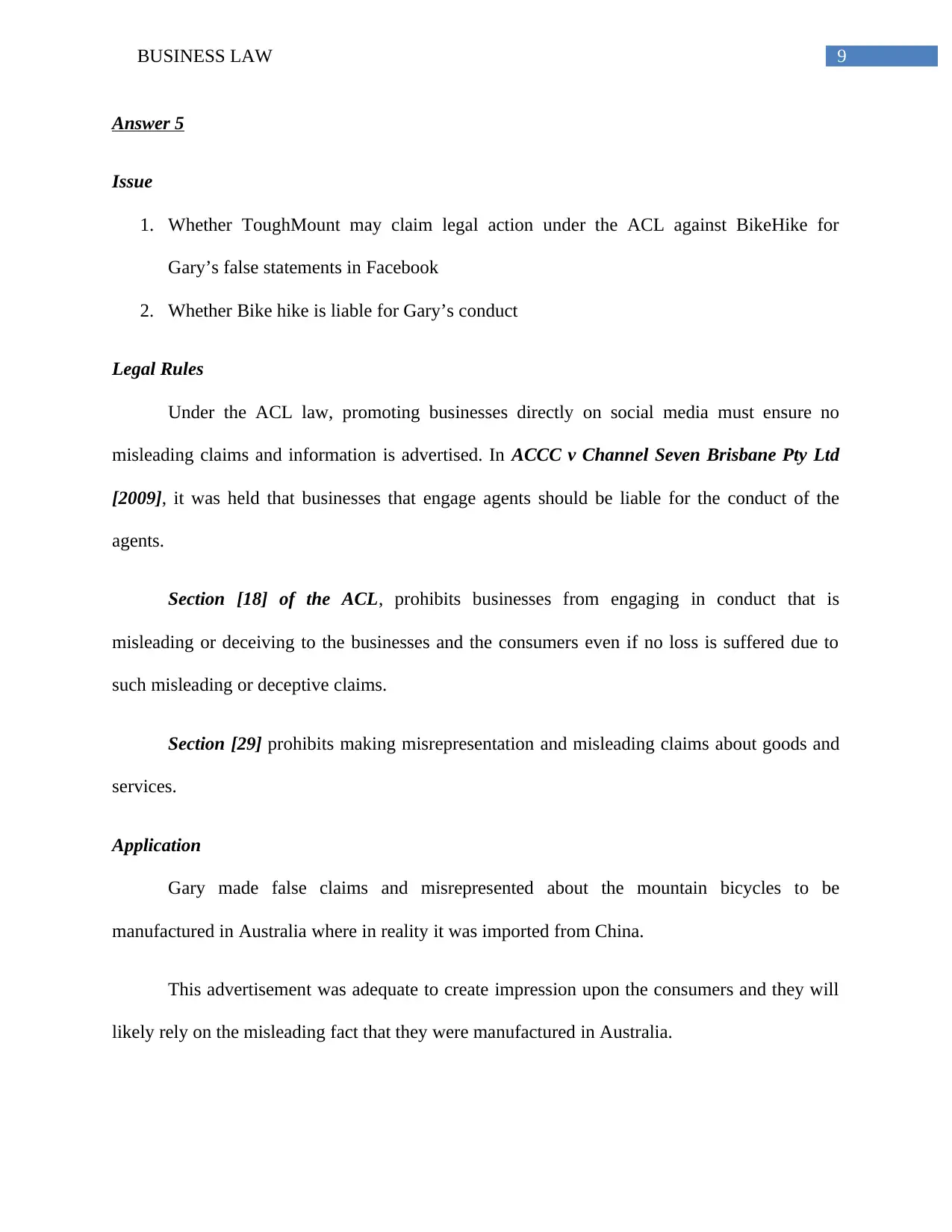
9BUSINESS LAW
Answer 5
Issue
1. Whether ToughMount may claim legal action under the ACL against BikeHike for
Gary’s false statements in Facebook
2. Whether Bike hike is liable for Gary’s conduct
Legal Rules
Under the ACL law, promoting businesses directly on social media must ensure no
misleading claims and information is advertised. In ACCC v Channel Seven Brisbane Pty Ltd
[2009], it was held that businesses that engage agents should be liable for the conduct of the
agents.
Section [18] of the ACL, prohibits businesses from engaging in conduct that is
misleading or deceiving to the businesses and the consumers even if no loss is suffered due to
such misleading or deceptive claims.
Section [29] prohibits making misrepresentation and misleading claims about goods and
services.
Application
Gary made false claims and misrepresented about the mountain bicycles to be
manufactured in Australia where in reality it was imported from China.
This advertisement was adequate to create impression upon the consumers and they will
likely rely on the misleading fact that they were manufactured in Australia.
Answer 5
Issue
1. Whether ToughMount may claim legal action under the ACL against BikeHike for
Gary’s false statements in Facebook
2. Whether Bike hike is liable for Gary’s conduct
Legal Rules
Under the ACL law, promoting businesses directly on social media must ensure no
misleading claims and information is advertised. In ACCC v Channel Seven Brisbane Pty Ltd
[2009], it was held that businesses that engage agents should be liable for the conduct of the
agents.
Section [18] of the ACL, prohibits businesses from engaging in conduct that is
misleading or deceiving to the businesses and the consumers even if no loss is suffered due to
such misleading or deceptive claims.
Section [29] prohibits making misrepresentation and misleading claims about goods and
services.
Application
Gary made false claims and misrepresented about the mountain bicycles to be
manufactured in Australia where in reality it was imported from China.
This advertisement was adequate to create impression upon the consumers and they will
likely rely on the misleading fact that they were manufactured in Australia.
⊘ This is a preview!⊘
Do you want full access?
Subscribe today to unlock all pages.

Trusted by 1+ million students worldwide
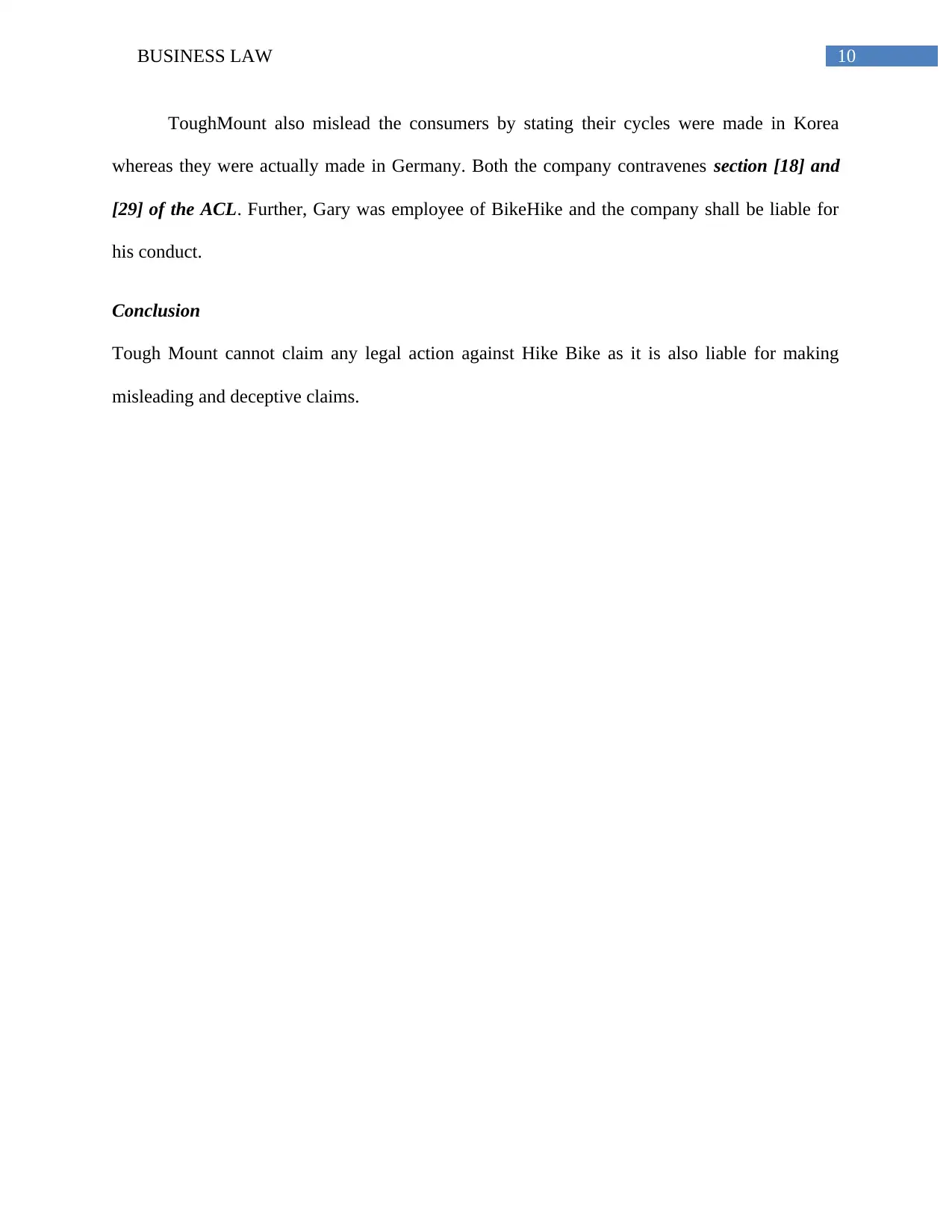
10BUSINESS LAW
ToughMount also mislead the consumers by stating their cycles were made in Korea
whereas they were actually made in Germany. Both the company contravenes section [18] and
[29] of the ACL. Further, Gary was employee of BikeHike and the company shall be liable for
his conduct.
Conclusion
Tough Mount cannot claim any legal action against Hike Bike as it is also liable for making
misleading and deceptive claims.
ToughMount also mislead the consumers by stating their cycles were made in Korea
whereas they were actually made in Germany. Both the company contravenes section [18] and
[29] of the ACL. Further, Gary was employee of BikeHike and the company shall be liable for
his conduct.
Conclusion
Tough Mount cannot claim any legal action against Hike Bike as it is also liable for making
misleading and deceptive claims.
Paraphrase This Document
Need a fresh take? Get an instant paraphrase of this document with our AI Paraphraser
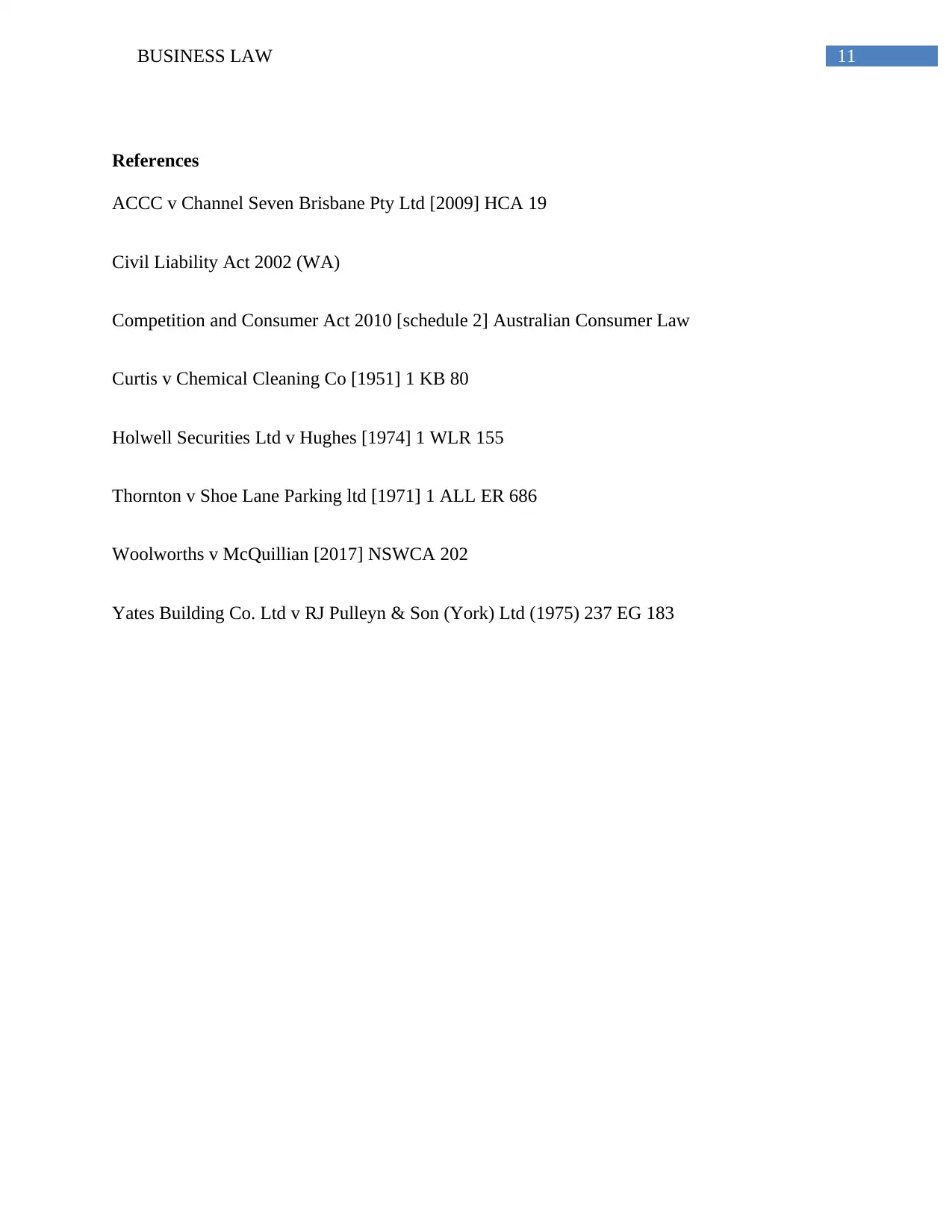
11BUSINESS LAW
References
ACCC v Channel Seven Brisbane Pty Ltd [2009] HCA 19
Civil Liability Act 2002 (WA)
Competition and Consumer Act 2010 [schedule 2] Australian Consumer Law
Curtis v Chemical Cleaning Co [1951] 1 KB 80
Holwell Securities Ltd v Hughes [1974] 1 WLR 155
Thornton v Shoe Lane Parking ltd [1971] 1 ALL ER 686
Woolworths v McQuillian [2017] NSWCA 202
Yates Building Co. Ltd v RJ Pulleyn & Son (York) Ltd (1975) 237 EG 183
References
ACCC v Channel Seven Brisbane Pty Ltd [2009] HCA 19
Civil Liability Act 2002 (WA)
Competition and Consumer Act 2010 [schedule 2] Australian Consumer Law
Curtis v Chemical Cleaning Co [1951] 1 KB 80
Holwell Securities Ltd v Hughes [1974] 1 WLR 155
Thornton v Shoe Lane Parking ltd [1971] 1 ALL ER 686
Woolworths v McQuillian [2017] NSWCA 202
Yates Building Co. Ltd v RJ Pulleyn & Son (York) Ltd (1975) 237 EG 183
1 out of 11
Related Documents
Your All-in-One AI-Powered Toolkit for Academic Success.
+13062052269
info@desklib.com
Available 24*7 on WhatsApp / Email
![[object Object]](/_next/static/media/star-bottom.7253800d.svg)
Unlock your academic potential
Copyright © 2020–2025 A2Z Services. All Rights Reserved. Developed and managed by ZUCOL.




